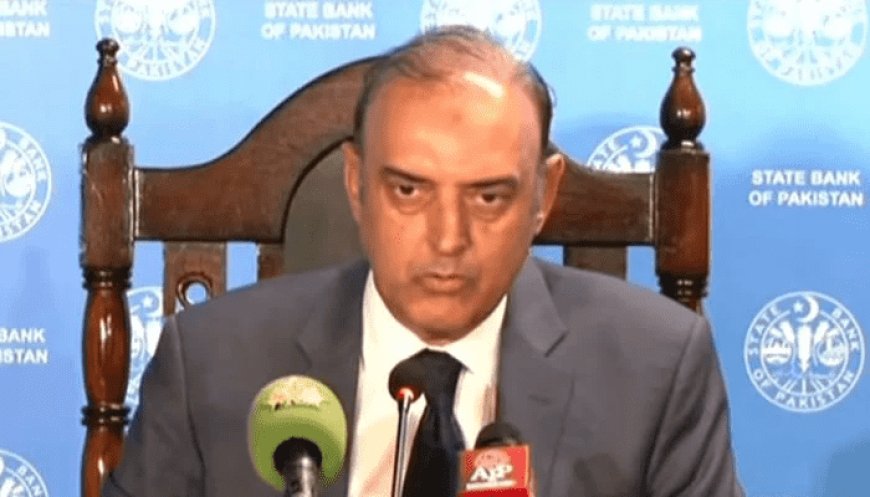SBP cuts policy rate by 100bps to 19.5% as inflation cools down 'slightly'

1. SBP Governor Jameel Ahmed says inflation rate eased to 12.60%, while external account continues to improve
- Current account deficit narrowed sharply in FY24: SBP governor.
- Says FX reserves improved from $4.4 billion to above $9 billion.
- MPC assesses FY25 real GDP growth in range of 2.5% to 3.5%.
The State Bank of Pakistan (SBP) on Monday reduced the interest rate by 1% or 100 basis points (bps) from 20.5% to 19.5%, the second cut in a row, citing a slight cooling in the inflation rate — a move that is mostly in line with the general market consensus.
Addressing a press conference after the Monetary Policy Committee (MPC) meeting, SBP Governor Jameel Ahmad said, "We have noted that the inflation is on a declining trend.”
"The inflation rate has come down to 12.60% from 38% while the external account has continued to improve," the SBP governor said adding, "The reduction in the interest rate reflects our confidence in the current economic trajectory."
Last month, the SBP's MPC trimmed its benchmark interest rate by 150 bps to 20.5%, following a record-high 22% that had been maintained for almost a year.
The finance czar further stated that "future projections expect the average inflation rate to stabilise between 23% and 25%, following last year's 23.4%".
The central bank in a statement said the announcement of monetary easing showed positive indicators for the national economy citing a slight drop in inflation, a build-up in SBP’s foreign exchange (FX) reserves despite repayments of debt, and a staff-level agreement with the International Monetary Fund (IMF) for a 37-month extended fund facility (EFF) programme of about $7.0 billion.
It added that the committee assessed that the external account has continued to improve, as reflected by the build-up in the central bank’s FX reserves despite substantial repayments of debt and other obligations.
The developments – along with significantly positive real interest rates – led to the further reduction in the policy rate in a calibrated manner to support economic activity, while keeping inflationary pressures in check.
Since its last meeting, the committee noted the key developments that the current account deficit narrowed sharply in FY24 and SBP’s FX reserves improved significantly from $4.4 billion at the end of June 2023 to above $9.0 billion.
The sentiment surveys conducted in July showed a worsening in inflation expectations and confidence of both consumers and businesses, the statement read.
It adds that international oil prices have remained volatile in recent weeks, whereas prices of metals and food items have eased.
Lastly, with the ease in inflationary pressures and labour market conditions, central banks in advanced economies have also started to cut their policy rates.
Taking stock of the developments, the MPC assessed that, despite today’s decision, the monetary policy stance remains adequately tight to guide inflation towards the medium-term target of 5% – 7%.
The assessment is also contingent on achieving the targeted fiscal consolidation, timely realisation of planned external inflows and addressing underlying weaknesses in the economy through structural reforms, it added.
Real sector
“Latest high-frequency indicators continue to reflect moderate economic activity. Auto and POL (excluding FO) sales and fertiliser offtake increased on a month-on-month basis in June. Large-scale manufacturing also recorded a sharp improvement in May 2024, mainly driven by the apparel sector.”
“The growth in agriculture sector, after showing a strong performance in FY24, is expected to slow down in this fiscal year. Latest satellite images and input conditions for Kharif crops also support this assessment.”
However, activity in the industry and services sectors is expected to recover, supported by relatively lower interest rates and higher budgeted development spending. Based on this, the MPC assessed FY25 real GDP growth in the range of 2.5% to 3.5% as compared to 2.4% recorded last year.
External sector
After recording surpluses for three consecutive months, the current account posted a deficit in May and June, in line with the MPC’s expectation. The recorded deficits were largely due to higher dividend and profit payments and a seasonal increase in imports, which more than offset a significant increase in exports and workers’ remittances.
Cumulatively, the current account deficit in FY24 narrowed significantly to 0.2% of GDP from 1.0% in the preceding year. This, along with the revival of financial inflows, helped build the SBP’s FX reserves.
Looking ahead, the MPC expects a modest increase in imports, in line with the growth outlook.
At the same time, the continued robust growth in workers’ remittances, along with an increase in exports, is expected to contain the current account deficit in the range of 0 - 1.0% of GDP in FY25.
The committee assessed that the expected financial inflows, including planned official flows under the IMF program, would help finance this current account deficit and further strengthen the FX buffers.
Fiscal sector
The government’s revised estimates indicate improvement in fiscal balances during FY24, as the primary balance turned into a surplus and the overall deficit declined from last year. However, amidst a shortfall in budgeted external and non-bank financing, the government’s reliance on the domestic banking system increased significantly.
The committee expressed concern about increasing reliance on banks for deficit financing, which has been squeezing borrowing space for the private sector.
For FY25, the government has set the primary surplus target at 2.0% of the GDP.
The MPC emphasised achieving the envisaged fiscal consolidation and timely realisation of planned external inflows to support overall macroeconomic stability and build fiscal and external buffers for the country to respond to future economic shocks.
Money and credit
The committee noted that the trends and composition of monetary aggregates during FY24 remained consistent with the tight monetary policy stance.
Broad money (M2) and reserve money grew by 16.0% and 2.6%, respectively, well below the growth in nominal GDP. Almost the entire growth in M2 was led by bank deposits, while currency in circulation remained almost at last year’s level.
As a result, the currency-to-deposit ratio improved, as it declined from 41.1% at end-June 2023 to 33.6% at end-June 2024.
At the same time, the improvement in external account increased the contribution of net foreign assets in monetary expansion.
Meanwhile, the growth in net domestic assets of the banking system decelerated amidst subdued demand for private sector credit. The Committee viewed these developments as favourable for the inflation outlook, the statement read.
Inflation outlook
As expected, headline inflation rose to 12.6% on a year-on-year basis in June 2024 from 11.8% in May. This increase was primarily driven by higher electricity tariffs and Eid-related increase in prices, which were partly offset by the downward adjustments in domestic fuel prices.
Core inflation, meanwhile, has steadied around 14% over the past two months.
The MPC assessed that while the inflationary impact of the FY25 budget is largely in line with expectations, the available information indicates that the full impact of these measures may now take some time to fully reflect in domestic prices.
At the same time, the Committee noted risks to the inflation outlook from fiscal slippages and ad-hoc decisions related to energy price adjustments.
On balance, after considering these trends – and accounting for the sufficiently tight monetary policy stance and ongoing fiscal consolidation – average inflation is expected to remain in the range of 11.5 – 13.5% in FY25, down significantly from 23.4% in FY24.

















































